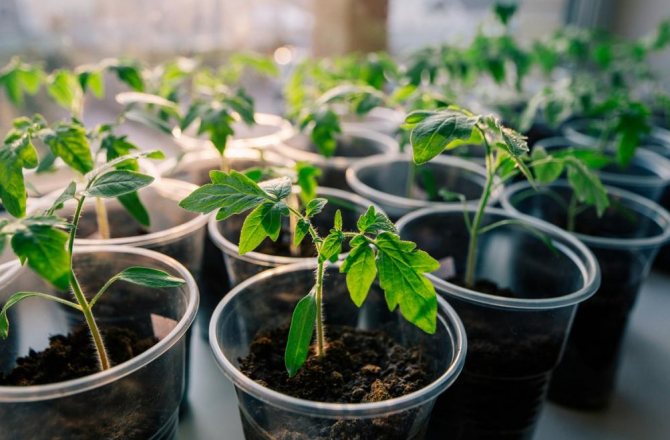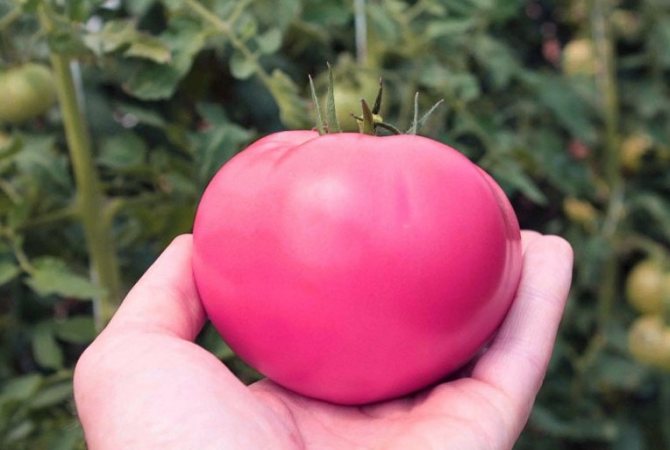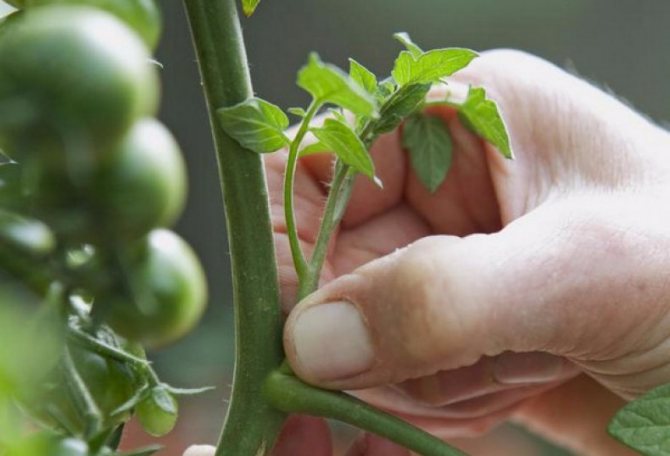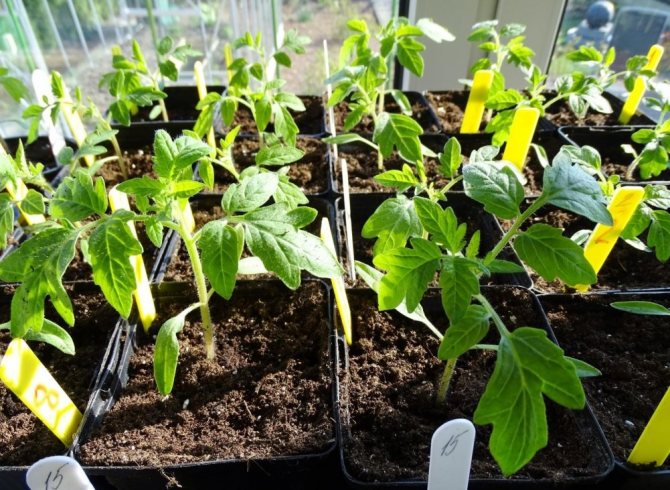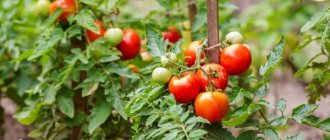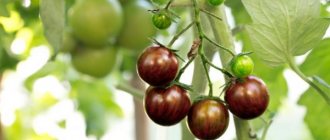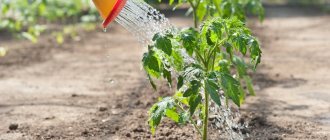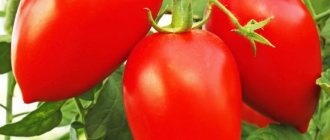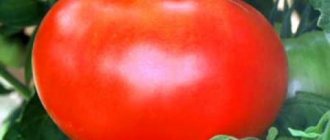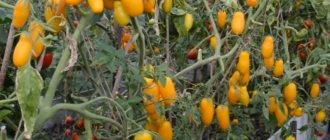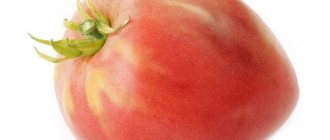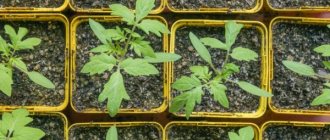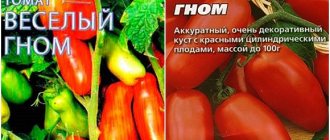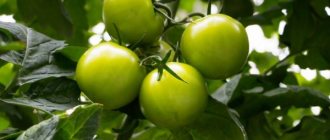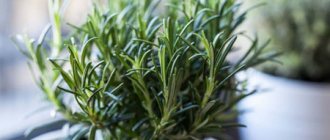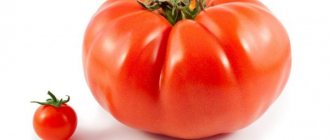History of creation
The hybrid Rosemary (more correctly called Rosamarin f1) was bred by biologists of the Scientific Research Institute of Vegetable Breeding and Agrofirm Gavrish in 2003.
It was entered into the State Register of Breeding Achievements of the Russian Federation in 2004. Approved for cultivation in all regions of the country in open ground under temporary shelter and in film-type greenhouses. The hybrid is specially bred for the spring-summer turnover.
In the photo - tomato rosemary f1.
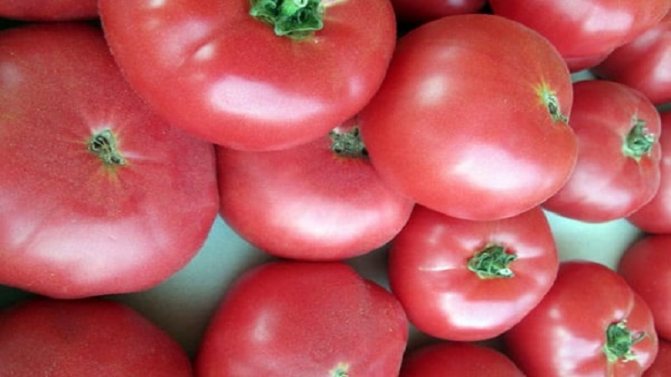
Description of the hybrid
The table contains the distinctive features of the tomato.
| Indicators | Characteristic |
| Weight | 250-350 g |
| The form | Flat-round, slightly ribbed. |
| Coloration | Pink, with a dark green spot near the stalk. |
| Leaves | Large, dark green. |
| Inflorescence type | Plain. |
| Number of ovaries | Five or more. |
| Peduncle | With articulation. |
| Number of nests | More than four. |
| Pulp | Juicy, soft, sugary, with a pronounced "tomato" aroma and few seeds. |
| Taste | Sweet, cuddly. |
| Skin | Thin, shiny, prone to damage. |
| Appointment | For fresh consumption. |
| Bush | Indeterminate, 1.5 - in open ground, 1.8-2 m - in closed. |
| Ripening period | 112-120 days from the moment of emergence. |
| Yield | 9-13 kg / m² or 4-5 kg per bush. |
| Sustainability | To viral diseases. |
| Transportability | Low. |
Reference. The pulp of the fruit Rosemary contains twice as much vitamin A as other tomatoes.
Useful video
And in the table below you will find links to articles on tomatoes of a wide variety of ripening periods that you may find useful:
| Super early | Mid-season | Medium early |
| White filling | Black moor | Khlynovsky F1 |
| Moscow stars | Tsar Peter | One hundred pounds |
| Room surprise | Alpatieva 905 a | Orange Giant |
| Aurora F1 | Favorite F1 | Sugar Giant |
| Severenok F1 | La La Fa F1 | Rosalisa F1 |
| Katyusha | Right size | Em Champion |
| Labrador | Size free | Sultan F1 |
If you find an error, please select a piece of text and press Ctrl + Enter.
Pros and cons
Benefits of culture:
- large fruits;
- excellent taste and aroma;
- evenness of fruits in size;
- strong trunk structure;
- resistance to nightshade diseases and insect attacks;
- high vitamin A content;
- suitable for dietetic food.
Disadvantages:
- low level of keeping quality and transportation;
- thin skin cracks when moisture is deficient;
- tomatoes are not suitable for pickling and pickling;
- requires a film shelter in the open field;
- tall bushes need pinching and garter.
Agrotechnics of tomato
Growing rules are standard, as for everyone indeterminate hybrids:
- tomatoes are grown through seedlings;
- disembarkation is carried out in well-warmed soil;
- bushes are stepchild and tied to supports or trellis;
- provide moderate watering with warm water;
- the soil is periodically loosened or covered with mulch;
- carry out feeding with complex fertilizers.
Seed preparation
The seeds of the hybrid do not require additional disinfection, since they are processed in production. To increase the percentage of germination, the grains are soaked in ready-made growth stimulants - "Epin", "Immunocytofit", "Zircon", or use natural remedies:
- The juicy leaves of aloe are kept in the refrigerator for 24 hours, then the juice is squeezed out through cheesecloth and diluted with water 1: 1. The seeds are soaked in the solution for 4-6 hours. In addition to stimulating germination, aloe improves plant immunity.
- A handful of onion skins and 1 tsp. wood ash pour 500 ml of boiling water and leave for three days. Strain and soak the seeds in the infusion for 2-4 hours before use.
- Dissolve 1 tsp in a glass of warm water. natural honey. Soak seeds for 5-6 hours.
Important! Before processing in stimulants, the inoculum is soaked in thawed water at room temperature until it swells.
The soil
A mixture of turf, peat and humus in a 1: 1: 1 ratio is ideal for growing seedlings.
Before use, the substrate is calcined in an oven at a temperature of 100-110 ° C or steamed in a double boiler for an hour.
Sowing
Sowing is done in the last week of March or early April. The seedling boxes are filled with a damp substrate and the seeds are placed in furrows 1.5 cm deep at a distance of 2 cm. Top them covered with a 1 cm layer of soil and covered with glass or foil.
The boxes are taken to a dark, warm place. The optimum room temperature is not lower than +24 ° С.
Seedling care
The film or glass is removed after the sprouts appear. The boxes are taken out to a sunny place. Seedlings are watered as needed, after the top layer of the earth has dried.
To prevent the development of the fungus, the seedlings are taken out into fresh air for 20-30 minutes.
After the appearance of 3-4 true leaves, the sprouts are planted in separate containers made of peat or plastic, carefully pinching off the tip of the root.
Landing in the ground
The transfer of mature seedlings begins 60-65 days after germination, starting in mid-May. The site is chosen on the sunny side, since productivity decreases in the shade. The best predecessors of tomatoes are radishes, dill, parsley, cabbage.
The culture prefers light nutrient soil with neutral acidity - pH 7. The dense soil is loosened with river sand or peat. The soil is brought to normal with wood ash or chalk:
- sour - 400-500 g per 1 m²;
- medium sour - 200-300 kg 1 m²;
- slightly sour - 200 g per 1 m².
Dig holes for seedlings at a depth of 15-20 cm and fill with a strong solution of potassium permanganate, add 1 tbsp. l. superphosphate. The seedlings are watered abundantly with warm water and transferred together with an earthen clod from a plastic container or planted directly in a peat glass.
There are no more than three bushes per 1 m². Planting scheme - 40x60 cm.
Care
The culture is not demanding to care for, it prefers moderate watering and fertilizing with mineral compounds.
Care rules:
- The humidity level in the greenhouse should not exceed 70%.
- It is undesirable to overflow the soil, and at the same time allow it to dry out. The best solution to the watering issue is to install a drip system.
- For irrigation, rain or settled water is used.
- The bushes are stepchild once every 10 days and form into two stems.
- At the end of the growing season, pinch the top. The plant will stop growing, and all the energy will go to the tomatoes.
- A garter is performed not only on the stems, but also on flower brushes, which can break under the weight of the fruit.
- After watering, the soil is loosened to prevent the formation of a hard crust.
Advice... Cover the soil with mulch (sawdust, straw, hay, synthetic black agrofibre) to eliminate routine weeding and loosening, retain moisture and prevent fungal infestation.
Top dressing
Tomatoes are fed at least three times during the growing season according to the scheme:
- The first organic feeding 14 days after planting - chicken droppings with the addition of water in a ratio of 1:10 or ready-made products: "Humisol", "Veromistin".
- The second top dressing 14 days after the first - with a complex fertilizer "Solution" with calcium, manganese, potassium and phosphorus in the composition. For 1 bush - 2 liters of solution.
- The third subcortex during the period of fruit emergence "Solution" 2.5-3 liters for each bush.
Growing difficulties
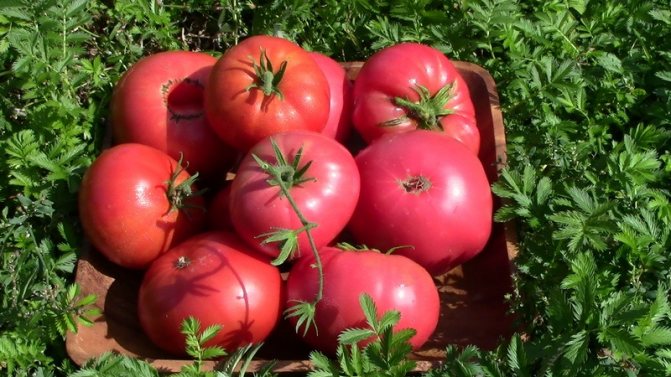

Tomatoes are sensitive to both a deficiency and an overabundance of mineral components. By the appearance of the bushes, it is easy to determine the state of the plant:
- Gains green mass, but does not bloom - an excess of nitrogen in the soil. Wood ash will help reduce its amount.
- Bushes stretch upward, leaves turn pale - nitrogen deficiency.
- Leaves acquire a purple hue with a deficiency of phosphorus, fall off - with an overabundance.
- The green mass becomes dull when there is an overabundance of potassium and dries up when it is deficient.
Landing
Tomatoes are grown in seedlings. The key to success is high-quality seed purchased from a trusted manufacturer.
At the end of March, pre-planting seed preparation is carried out: dressing in a solution of potassium permanganate (1%) and preparation of a soil mixture - a mixture of humus and peat, heated in an oven at 100-110 ° C.
In early April, the soil substrate is poured into the planting container, shallow grooves (1.5-2 cm) are made in one direction, and spilled with water.
To accelerate germination, seeds are treated with growth stimulants before sowing.
Tomatoes are sown at a distance of about 1.5-2 cm from each other, sprinkled with a minimum layer of soil mixture and covered with film or glass until shoots appear. The soil should always remain moist and warm up to 24-25 ° C by the sun.
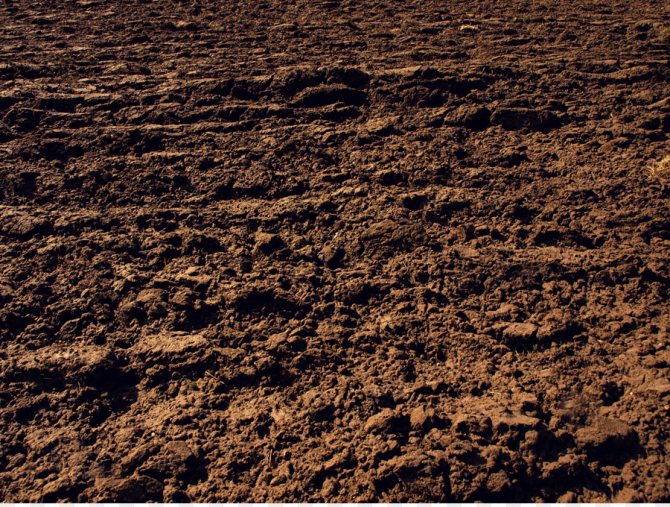

The soil must be moist and warm
After the emergence of seedlings, the shelter is removed, the temperature in the room is gradually lowered. At the stage of 3-4 true leaves, the seedlings are dived into individual containers.
The final planting in a permanent place in the greenhouse is carried out in May, at an air temperature of at least 10 ° C. It should be borne in mind that tomatoes Rosemary F1, according to all descriptions, are very powerful plants; seedlings should be planted at a distance of at least 0.6-0.7 meters from each other. There are no more than 3-4 plants per square meter of area.
Tomatoes are grown in regions with different climates, so the time for sowing seeds is different.
You should focus on the time when the seedlings can be planted in a film greenhouse. From this date, 70 days are counted back - you get the desired sowing date. It will take five to seven days to process and germinate seeds. The remaining 60-65 days, the seedlings will grow indoors.
Before planting, the seeds are pickled:
- Make a weak solution of potassium permanganate.
- Soak for 20 minutes.
- Rinse well with clean water.
The seeds are sown in light peat soil. The substrate is poured into flat boxes 7-10 cm deep, grooves are made, seeds are laid out, and covered. After watering, the box is covered with foil or glass. In the room you need to maintain a temperature of 20-25 degrees.
As soon as the first shoots appear, the film is removed and the box is moved to the brightest, cool place. The thermometer should be 12-18 degrees. This is necessary so that the naturally tall and intensively growing rosemary seedlings do not stretch out.
Elongated bushes do not take root well and are not able to give the maximum yield.
Seedlings should be fed once with any complex fertilizer for tomatoes (Agricola, Ideal). Seedlings must be planted in separate pots - this will accelerate the survival rate in a permanent place.
The seedlings are hardened during the week - they are taken out into the open air in the daytime, so that they get used to the sun's rays and cold air.
Outdoor care consists of fertilizing, watering and shaping. During the growing season, the plants need to be fed 3 times with mullein infusion or azofoska dissolved in water. Vines are formed into two stems and carefully tied up so that they do not break under the weight of massive fruits.
Mid / Tall
User score: 4/5
Mid / Tall
User score: 4/5
Medium early / Tall
Prevention of diseases and pests
The Rosemary hybrid is genetically protected from infection with viral diseases of the nightshade (verticellosis, fusarium, tomato mosaic). Seed producers claim that the culture is not afraid of late blight (brown spots, whitish bloom on the leaves and trunks, the ugly shape of the fruit).
However, prevention will not be superfluous:
- soil cultivation with copper sulfate;
- disinfection of greenhouses with sulfur checkers;
- removal of the lower yellowed leaves;
- control of the moisture level in the greenhouse;
- moderate watering at the root;
- covering the soil with mulch.
The main problem that gardeners face when cultivating a tomato is leaf curling. If you do not take measures in time, you can be left without a crop. The reason for this condition lies in the overabundance of organic fertilizers in the soil, the air temperature in the greenhouse is above +32 ° C, and the deficiency of copper.
Ways to solve the problem:
- the introduction of phosphorus-potassium fertilizers;
- treatment with Agrofon containing copper;
- ventilation of greenhouses to normalize the temperature regime.
The hybrid is often attacked by a bear, Colorado potato beetle, whitefly, aphids, caterpillars. Modern safe insecticides help to fight pests: "Thunder", "Fitoverm", "Iskra", "Force", "Epin", "Confidor", "Commander".
Bush care
Recommendations for further care:
- To get a good harvest, the frequency of watering should be once every 5 days, in dry weather. It is not recommended to use cold water for irrigation. In case of prolonged absence of precipitation, periodic spraying of tomato foliage is recommended;
- The next day after watering, carefully loosen the soil around the seedlings;
- Despite the massiveness and strength, the bushes must be tied up with synthetic material;
- Top dressing is carried out in stages. The first feeding is carried out two weeks after transplanting to a permanent place. During the formation of the ovaries, a boric acid solution is used. Further feeding is carried out after 10 days using complex fertilizers;
- The tomato bed must be cleaned of weeds in a timely manner. To reduce the amount of weeding, it is recommended to mulch the soil with non-woven black fiber. Also, straw, mown grass, leaves can serve as mulch. They will become an additional source of organic nutrition for tomato crops;
The formation of the bush is carried out in two or three stems.
By the appearance of a tomato crop, it is possible to determine the deficiency and excess of microelements:
- With a lack of nitrogen, the leaves become pale, and an excess of nitrogen provokes an excessive growth of green mass;
- With an insufficient amount of phosphorus, a purple tint appears in the leaves, while an excess amount causes the ovaries and leaves to fall off;
- With a lack of potassium, the plant begins to dry out, even despite proper care and watering, the appearance of a matte shade on the leaves indicates an excess amount of potassium.
Harvest application
The first fruits appear approximately 112 days after germination. Tomatoes are removed carefully, twisting them out of the stalk, being careful not to damage the thin skin. The shelf life is minimal, so they try to use them immediately.
The fruits are eaten fresh. Because of the delicate skin, tomatoes are completely unsuitable for pickling and pickling whole.
Too soft tomatoes are used for adjika, lecho, sauce, juice, tomato paste.
Yield
Planting density - 3 plants per square meter. The scheme is 40 by 70 cm. Tomatoes are grown only in seedlings. The optimum age of seedlings at the time of disembarkation is 60 days.
To obtain larger fruits, the clusters can be normalized, leaving three tomatoes on each. Tomato responds gratefully to spraying with fruiting stimulants. Ovary or Bud will do.
Due to the delicate pulp and thin skin, the fruits cannot be stored for a long time. Ripe tomatoes are best kept in the refrigerator, where they will lie for several days. Brown can be ripened indoors.
Testimonials
The impressions of growing this large-fruited hybrid among gardeners are mostly positive.
Elena, Kstovo: “Before deciding to grow rosemary tomatoes, I read the reviews of those who planted. Inspired, I acquired seeds. The characteristics and descriptions of tomatoes on the package are true. The seedlings grew strong, they did not feed them with anything. Moved to the greenhouse in early June. From fertilizers, I introduced chicken manure and potassium-phosphorus fertilizers. Watered with warm water once a week under a bush. In drought, the frequency was increased to two irrigations. The harvest was a success, I didn’t eat more delicious tomatoes ”.
Yaroslav, Borisoglebsk: “Last year I tried to grow Rosemary in a vegetable garden, before that I planted it in a greenhouse. Bushes are strong, with a thick stem, tall. Tied to wooden stakes, covered with foil in extreme heat. I did not notice any special problems in leaving. The main thing is to water and feed in moderation. The tomatoes have grown large, fleshy and very sweet. "
Growing features
Rosemary is a tomato variety that does not require any special care. Sowing seeds for seedlings should be carried out in the first decade of April. Seeds, according to gardeners' reviews, are best treated with potassium permanganate. The pick should be carried out at the stage of 2-3 leaves. Transfer to the ground after reaching the age of two months.
There are a huge number of ways to grow tomato seedlings. We bring to your attention a series of articles on how to do this:
- in twists;
- in two roots;
- in peat tablets;
- without picking;
- on Chinese technology;
- in bottles;
- in peat pots;
- without land.
Further care will be reduced to tying the stem, fruit brushes, periodically loosening the soil, watering with warm water after sunset. Harvesting is carried out as the tomatoes ripen and can be extended over time.
Read useful articles about fertilizers for tomatoes:
- Organic, mineral, phosphorus, complex and ready-made fertilizers, for seedlings and TOP of the best.
- Yeast, iodine, ammonia, hydrogen peroxide, ash, boric acid.
- What is foliar dressing and when picking, how to carry it out.

